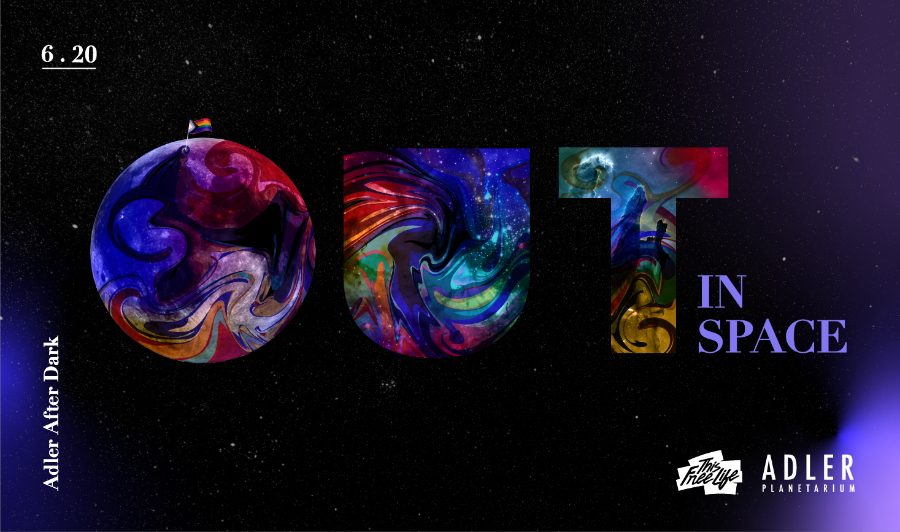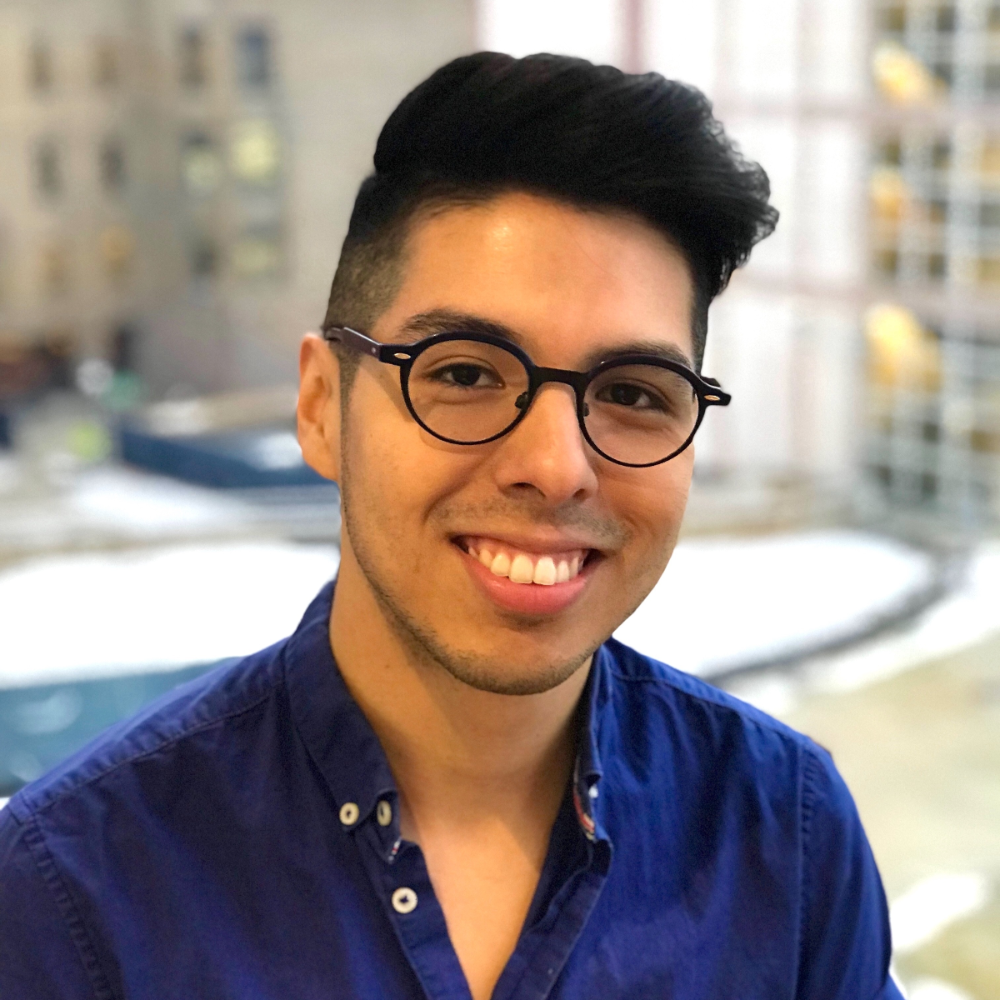Meet “Out in Space” Panelist: Bryan Terrazas

Meet Dr. Bryan A. Terrazas, NSF Fellow and Rackham Merit Fellow in the Department of Astronomy at the University of Michigan, at Adler After Dark: Out in Space! Dr. Terrazas will be featured in a panel discussion about the importance of having a broad range of perspectives in the scientific community.

Why have you chosen to pursue astrophysics as a career?
My interest in astrophysics stems from the fact that it deals with things that we as humans cannot touch, move, or manipulate. The objects we study in space are incredibly far away, enormous in size, and operate at timescales of millions to billions of years. Their existence is completely different from what we experience in our day-to-day lives. Because of this, instead of being hands-on experimentalists, astrophysicists are mostly observers and interpreters. We live on a planet revolving around one of billions of stars in our galaxy which is one of billions of galaxies in our universe. Yet we’ve developed methods for understanding the universe through mathematics and the scientific process that give us remarkable insights into the way things operate in space.
It takes persistence and, most importantly, a lot of creativity to tease out information about the universe from our limited human perspective. Figuring out creative solutions to the universe’s biggest unsolved mysteries is detective work that requires piecing together evidence and writing down a consistent story for how things work. This is a difficult but incredibly rewarding task. I find it very exciting to devote my career to expanding our knowledge about the universe.
Can you tell us a little bit about your research and work on galaxies?
I care about how galaxies have grown and evolved throughout the history of the universe. More specifically, I want to know why some galaxies are actively forming new stars, while others are not. Star formation is one major way a galaxy grows, so it’s concerning when a large number of galaxies have stopped the majority of their star formation. There are many ideas for what could lower the rate of star formation, but the most popular theory today has to do with the supermassive black hole that resides at the center of most if not all galaxies. My work focuses on the connection between these central supermassive black holes and the amount of star formation in their host galaxies.
Specifically, my collaborators and I have shown that galaxies with more massive black holes have suppressed star formation activity to a greater extent than those with less massive black holes. However, a coherent picture of how this process works in galaxies has yet to be discovered. In September, I’ll be starting a postdoctoral fellowship at the Center for Astrophysics at Harvard & Smithsonian where I’ll be gathering more evidence and trying to piece together a complete narrative for how black holes affect galaxies.
While at the University of Michigan, you led the effort for the creation of the Committee on Equity and Inclusion within the Astronomy Department. What motivated you to do this?
The motivation came from the 2015 National Society of Black Physicists Conference in Baltimore, MD. Together with my close friend and fellow graduate student at the time, Alejo, we came up with the idea after many discussions on how we could improve recruitment and climate for black and brown scientists. We had proposed the idea of sending representatives from the University of Michigan to the meeting and we decided that we would go a step further by proposing an official committee. We felt the need to do this because, through those conversations, we had identified several specific areas where the department could improve through more direct and concrete actions. Profs. Emily Rauscher and Nuria Calvet, who were also in attendance at the meeting, said they would provide full support and help present a case to the department through a formal presentation. We were successful, and the committee began its work a few months later during the 2015 Fall semester.
What was the vision and goal of the committee?
We envisioned the committee as an institutionally-recognized group of department members from all levels who would actively think about how to make the astronomy department a safe and welcoming space in which anybody could do science. Academia is predominantly made up of people who are white, male, cisnormative, heteronormative, non-disabled, and wealthy. In order to make the department welcoming for all, particular effort needed to be aimed at ensuring that people who do not fit into those demographics were being actively recruited to the program and supported throughout their time here. This last point is important: it was vital that the committee have the power to address issues regarding climate in order to ensure that those who were being recruited would feel safe and supported as they build their careers.
Since 2015, what changes have you noticed in the department as a result of the committee?
Since its inception, the committee has done a lot for the department. In terms of graduate admissions and recruitment for the next generation of astrophysics PhDs, they have organized recruitment efforts and attendance at meetings for underrepresented folks in science (e.g., NSBP, SACNAS), eliminated the physics GRE requirement, and introduced methods for avoiding bias when assessing applications. Additionally, they have organized a bimonthly event for the discussion of various social issues present in the scientific community, introduced gender-neutral signage for departmental restrooms, and centralized clear and transparent guidelines for dealing with issues of harassment. Change is slow and often frustrating when going against the status quo that everybody is used to, but it’s wonderful to reflect back and be able to concretely list these successful outcomes after four years. A lot more work needs to be done, but the committee has been a great first step forward.
When did you first become passionate about improving the climate for underrepresented minorities in astronomy and the broader STEM community? What sparked the desire to be someone who advocates on behalf of others?
Coming into my PhD program, I was in the extreme minority as a queer Latinx graduate student and first generation both in terms of attending university but also as a US citizen. Academia caters to a specific demographic and socio-economic status that often creates a hostile environment for people who don’t fit that mold. What’s worse is that it often goes unnoticed by people who do fit that mold. Throughout my PhD program I had moments of questioning whether it was worth dealing with each microaggression as it came up and constantly having to defend the importance of equity and inclusion issues to people in power who didn’t have a clue what it meant to be someone like me in that space. All this feeds and adds a layer to the impostor syndrome that affects many underrepresented people in science.
Every time I felt that way, I knew I wanted to work with similarly-minded people to change that culture. I wasn’t the only person with these feelings and that gave me the impetus to reach out and start organizing with people. Some of the most influential of those were Chanda Prescod-Weinstein, Jedidah Isler, and Jorge Moreno who have all been incredibly influential to me with regards to the way in which I engage with these issues and also the way I balance my science work with my advocacy work. The community of scientists who care about these issues have done a tremendous amount of work to ensure the survival of bright, young scientists who would otherwise likely be discouraged from pursuing science. My hope is that in the future the conversation will shift to focus not on how we can survive but rather how we can thrive.
In your opinion, why is it important to have LGBTQIA+ representation in the scientific community?
LGBTQIA+ scientists are often invisible. Work discussions don’t center around that aspect of people’s identity, particularly in astronomy where we talk about stars and galaxies but not so much about gender expression or identity, for instance. Yet, heteronormative and cisnormative culture and expression are everywhere in the scientific community. Having spoken to other queer scientists, I realized that often there was an internalized tendency to assimilate into this world of professional cis-hetero-normativity. This is a big problem. Having openly queer folks in science changes the common perception of what a scientist is and what they should look like. I also want to note that this is absolutely an intersectional issue. It’s critical that movements that seek to advocate for LGBTQIA+ people also do so for black and brown people, people with disabilities, people with lower socio-economic backgrounds, women, and people who are any combination of these identities.
If you could snap your fingers and change one thing about the scientific community as a whole, what would it be?
If I could only choose one thing, it’d be dismantling the top-down hierarchies of power in academia and building new power structures that are more equitable and inclusive.
In my experience, top-down hierarchical power structures enable imbalances in determining who is heard and what action is taken. When this is the case, a few people can make decisions that affect groups of people who have little to no say and who are likely not represented in the decision-making process. This can be devastating for people with less power who need to find support against climate issues ranging from microaggressions, sexual or gender harassment, abuses of power, or any other problems that may arise. There are people in power who have used their positions to advocate for those who need support but this is generally insufficient and unsustainable. If the scientific community wants to become a more inclusive and welcoming space, there needs to be institutional structures in place that allow power to be distributed equitably across all members of the community. This is far from the only change that needs to be made, but I believe that by redistributing power, more voices will be heard and a first step can be taken towards improving the climate in the scientific community.
Want to get to know more about Bryan? Follow him online!
Website: bryanterrazas.weebly.com
Twitter: @bryan_terrazas






